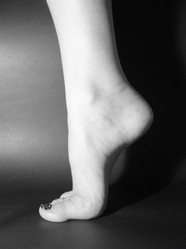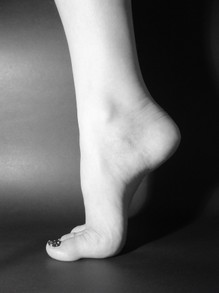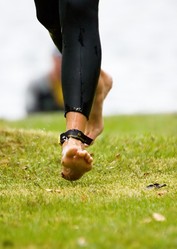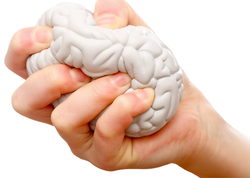Treatment of foot strain is essentially the treatment of the adult flat-foot. In acute strain, rest is desirable and walking must be curtailed or completely eliminated. Application of heat or cold may be used depending upon which affords the greater relief. Early use of cold, and later the use of heat is generally preferred. The use of alternating hot and cold baths is soothing. Stimulation of the plantar muscles with faradic current allegedly affords comfort by decreasing the soft-tissue inflammation. When the symptoms are sufficiently severe or fail to respond to brief rest, immobilization of the foot in a plaster cast may be indicated. A cast removes all stress from the intrinsic muscles of the foot and gives total rest while still permitting ambulation. After the acute symptoms have subsided, rehabilitation of the foot must be undertaken. Often the patient’s history indicates that pain began after a change in occupation, a change in activities involving excessive standing or walking, a period of excessive weight gain, or a period of immobilization causing disuse wasting of the muscles. It is not unusual to find that symptoms began with the wearing of a different type of shoe. These factors are very often the cause of foot pain and once discovered must be altered or remedied.

Foot Strain Treatment and Exercises
by John84
Treatment of foot strain is essentially the treatment of the adult flat-foot. In acute strain, rest is desirable and walking must be curtailed or completely eliminated.
Exercises for Foot Strain
Exercises similar to those given the child with pronated feet are extremely valuable for patients up to the age of 50 and can be of value even at a later stage in life. These exercises preferably are done barefooted. While seated, the patient turns the foot down, in, up, and out drawing a wide circle. This must be done forcefully, with every effort to get the fullest possible range of motion. Simultaneously, the toes should be alternately flexed and extended. This type of exercise elongates the tissues and strengthens the muscles of the leg and foot. Circulation is also enhanced.
Similar exercises can be performed standing. The patient stands with feet apart and slight toeing in. Rolling to the outer border of the feet, the patient simultaneously curls the toes forcefully. Rising on the toes strengthens the calf group and the toe flexors, and the patient should be encouraged to practice walking on his toes with a slight pigeon-toed gait. If the heel cord is tight, it can be stretched by exercise in which the patient leans forward against a wall, keeping one leg behind, and the forward leg not weight-bearing. The posterior foot is kept facing straight ahead with the heel to the ground. As the patient leans toward the wall, the Achilles tendon is stretched. The toe flexors can be exercised by wrinkling a towel lying on the floor or picking up marbles with the toes.
All the exercises prescribed are of value when done daily and systematically for long periods. The patient should do these exercises while wearing shoes during the work day. The patient must be advised to walk with a slight toe-in gait and with a slight spring during push-off. Most important of all, the patient must walk increasing distances daily.
Corrective Shoes
Corrective shoes in the adult seek to decrease the strain causing pronation. An adult foot in which the abnormal articular structure is fixed cannot be modified, as can a child’s or an adult’s whose foot is flexible. The shoe is modified by elevating the inner border using a Thomas heel with an inner wedge of 1/8 to 3/16 inch. An inner wedge may' also be incorporated into the sole to raise the entire inner border of the shoe.
Tape with 1/4 inch adhesive-backed sponge rubber can be applied to elevate the portion of the foot desired. Several layers of moleskin or felt of varying thicknesses cut into the desired pattern and taped properly to the foot is also effective. Arch supports may help rehabilitate the flexible flatfoot. They must be molded to conform to the shape of the foot that is partially weight-bearing, yet properly formed; they are never molded to the shape of the non weight-bearing foot. They must be sufficiently firm to support the body weight without completely deforming. The shoe must be large enough to accommodate both the arch supports and the foot. Shoes must be fitted properly. As foot tone is best in the morning and the foot “spreads” and slightly deforms as the day progresses, shoes should be fitted late in the day. The shoe should be broad across the forefoot, have a firm-fitting counter, and have a last that conforms to the weight bearing print of the foot. It should be long enough to project 1 inch ahead of the big toe.
Women's Shoes
Women’s shoes should-have broad low heels, rounded toes, and a vamp that will not constrict the metatarsal heads. It is a sad commentary that women’s shoes are designed exclusively for style and custom, with no concern for comfort and health.
You might also like
What is Foot PronationFoot pronation is a sequence of foot strain imposed upon a normal foot but is...
How to Lower Cortisol Levels Reduce Stress Hormone and Improve...Cortisol is a steroid hormone regulating metabolism, the immune system and ai...




 How to deal with Anxietyon 10/20/2015
How to deal with Anxietyon 10/20/2015
 What Causes Anxiety and Stresson 10/20/2015
What Causes Anxiety and Stresson 10/20/2015
 Understanding How to Stop Tooth Painon 10/20/2015
Understanding How to Stop Tooth Painon 10/20/2015
 What is Metatarsalgia - Diagnosis and Treatmenton 09/10/2015
What is Metatarsalgia - Diagnosis and Treatmenton 09/10/2015


Comments